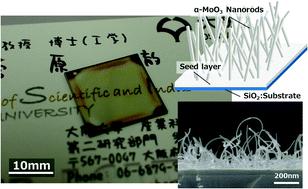当前位置:
X-MOL 学术
›
Mater. Chem. Front.
›
论文详情
Our official English website, www.x-mol.net, welcomes your
feedback! (Note: you will need to create a separate account there.)
Effects of additive NH3 with citric acid in the precursor and controlling the deposited thickness for growing molybdenum oxide crystals and nanorods
Materials Chemistry Frontiers ( IF 6.0 ) Pub Date : 2020-10-09 , DOI: 10.1039/d0qm00535e Yukiko Hirose 1, 2, 3, 4, 5 , Tohru Sugahara 1, 2, 3, 4, 5 , Jun-ichi Nakamura 5, 6, 7, 7, 8 , Nobuyuki Harada 5, 6, 7 , Katsuaki Suganuma 1, 2, 3, 4, 5
Materials Chemistry Frontiers ( IF 6.0 ) Pub Date : 2020-10-09 , DOI: 10.1039/d0qm00535e Yukiko Hirose 1, 2, 3, 4, 5 , Tohru Sugahara 1, 2, 3, 4, 5 , Jun-ichi Nakamura 5, 6, 7, 7, 8 , Nobuyuki Harada 5, 6, 7 , Katsuaki Suganuma 1, 2, 3, 4, 5
Affiliation

|
In recent years, researchers have successfully established a simple method for the production of fine single crystal-like α-MoO3 nanorod structures on substrates using a solution metal–organic decomposition (MOD) method to deposit film coatings. However, to grow α-MoO3 nanorods by the MOD method, an accurate mechanism between α-MoO3 nanorod extension and precursor preparation (contents of precursor conditions) should be identified. Here, we demonstrated controllable α-MoO3 nanorods and plate-like α-MoO3 crystal growth based on as-deposited film thickness by using different citric acid (CA) and ammonia (NH3) ratios in the precursor solutions. The α-MoO3 nanorod growth mechanisms are discussed in detail with the precursor conditions and deposition film thickness; excellent results were achieved in controlling the film thickness by preparation of the precursor viscosities. In addition, the effects of the CA and NH3 amounts on the α-MoO3 nanorods and crystal growth were investigated. It was found that NH3 plays an effective role in delaying the decomposition timing of CA, promotes the growth of α-MoO3 nanorods, and reduces the growth and increase of plate-like α-MoO3 crystals. The study obtained excellent results for the growth extension of α-MoO3 nanorods and plate-like α-MoO3 crystals, controlled by film thickness as the role of CA and NH3. The demonstrated strictly controlled α-MoO3 nanostructure forming process can be achieved with the solution MOD method.
中文翻译:

前体中柠檬酸对NH3添加剂的影响以及控制沉积厚度以生长氧化钼晶体和纳米棒的作用
近年来,研究人员已经成功地建立了用于生产细单晶样α-的MoO的简单方法3使用的溶液的金属有机分解(MOD)方法来沉积膜涂层基底的纳米棒的结构。然而,生长α-的MoO 3个纳米棒由MOD方法中,α-的MoO之间的精确机构3纳米棒的延伸和前体的制备(前体条件内容)应该被识别。在这里,我们证明了可控α-的MoO 3个纳米棒和板状α-的MoO 3通过使用不同的柠檬酸(CA)和氨基于如此沉积的膜厚度的晶体生长(NH 3)比率的前体溶液。α-的MoO 3详细讨论了纳米棒的生长机理,包括前驱体条件和沉积膜厚度。通过制备前体粘度在控制膜厚方面取得了极好的结果。此外,CA和NH的影响3种上的α的MoO量3个纳米棒和晶体生长的影响。据发现,NH 3起着延迟CA的分解定时的有效作用,促进了α-的MoO的生长3个纳米棒,并且降低了生长和板状α-的MoO的增加3晶体。该研究获得了优异的结果α-的MoO的生长延伸3纳米棒和板状α-的MoO 3晶体,由膜厚控制,作为CA和NH 3的作用。所表现出的严格控制α-的MoO 3的纳米结构形成过程可与溶液MOD方法来实现。
更新日期:2020-11-03
中文翻译:

前体中柠檬酸对NH3添加剂的影响以及控制沉积厚度以生长氧化钼晶体和纳米棒的作用
近年来,研究人员已经成功地建立了用于生产细单晶样α-的MoO的简单方法3使用的溶液的金属有机分解(MOD)方法来沉积膜涂层基底的纳米棒的结构。然而,生长α-的MoO 3个纳米棒由MOD方法中,α-的MoO之间的精确机构3纳米棒的延伸和前体的制备(前体条件内容)应该被识别。在这里,我们证明了可控α-的MoO 3个纳米棒和板状α-的MoO 3通过使用不同的柠檬酸(CA)和氨基于如此沉积的膜厚度的晶体生长(NH 3)比率的前体溶液。α-的MoO 3详细讨论了纳米棒的生长机理,包括前驱体条件和沉积膜厚度。通过制备前体粘度在控制膜厚方面取得了极好的结果。此外,CA和NH的影响3种上的α的MoO量3个纳米棒和晶体生长的影响。据发现,NH 3起着延迟CA的分解定时的有效作用,促进了α-的MoO的生长3个纳米棒,并且降低了生长和板状α-的MoO的增加3晶体。该研究获得了优异的结果α-的MoO的生长延伸3纳米棒和板状α-的MoO 3晶体,由膜厚控制,作为CA和NH 3的作用。所表现出的严格控制α-的MoO 3的纳米结构形成过程可与溶液MOD方法来实现。











































 京公网安备 11010802027423号
京公网安备 11010802027423号